Busia to Kisumu.
Getting up at the Blue York was an adventure.
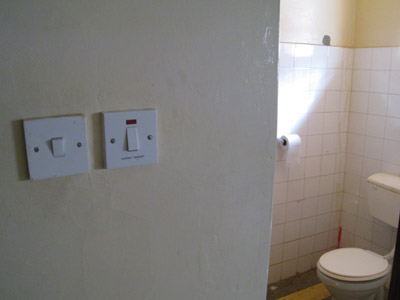
This was the switch outside the bathroom for the water heater.
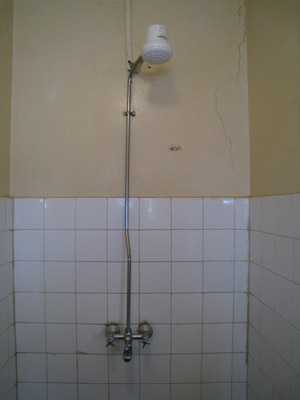
This was the shower, with a built-in instant water heater.
I switched on the water heater before attempting to shower, optimistically assuming this would cause the hot and cold water taps to work like they would in a regular shower. But no. The hot water tap controlled nothing; only the cold water tap would cause water to come out. The water started off frigid; then the heater gradually warmed it until it was scalding. Since there was no in-between setting, taking a shower consisted of standing under the water until it was burning hot, then running out (naked and dripping) to turn off the heater, returning to continue washing until the water was cold, running out to turn on the heater, washing until the water was scalding, running out, etc.
Of course, I know I should be thankful that there was any hot water at all.
We headed back to the IPA office for more tours of water sources and chlorine dispensers.
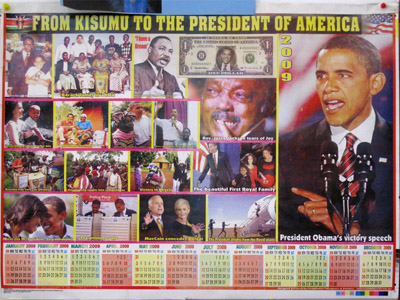
They had this amusing Obama calendar on the wall (click for a bigger view). Jeff later explained to us that the entire country just went nuts when Obama was elected - and not just Kenya but other African countries as well. Uganda had a two-day national holiday.
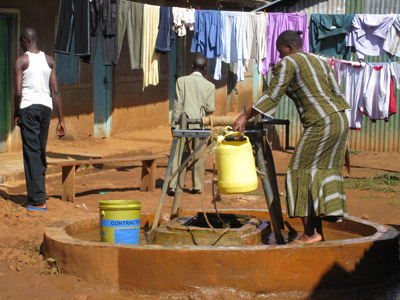
This was a well we visited in a peri-urban setting.
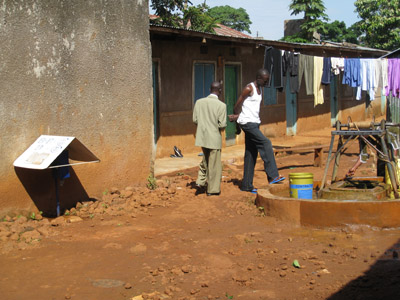
And this was the dispenser next to it. We had a long conversation with the woman who was in charge of refilling the dispenser, with Bukeke helpfully translating our questions into Swahili. She told us that the dispenser was like a blessing to her family. Before they had the dispenser, nearly every week, someone in her family would be sick and would have to go to the hospital; now, that hardly ever happens.
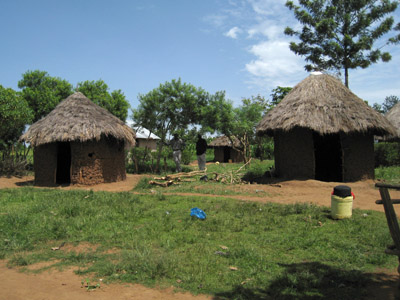
This was a family compound we visited in a rural area near Busia. Jeff explained that this was a pretty well-to-do family, comparatively speaking - in addition to the mud huts, they had one building with a corrugated metal roof (which you can just see behind the hut on the left), and a metal roof was a sign of wealth.
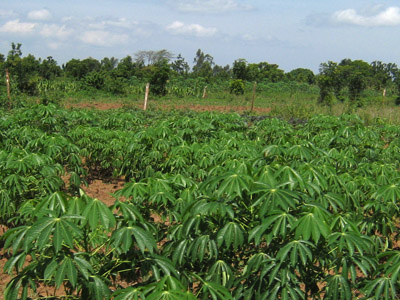
To get to the water source, we took a five-minute walk through some fields of cassava.
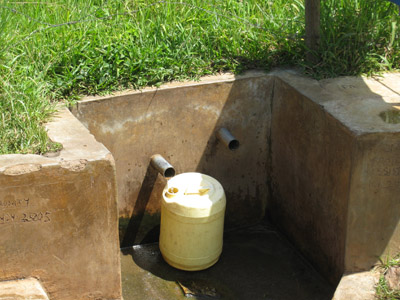
The water source was a protected spring, built by a previous IPA project.
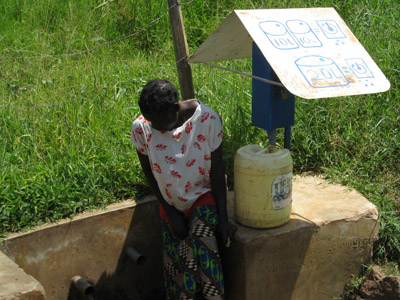
This was the chlorine dispenser next to the spring.
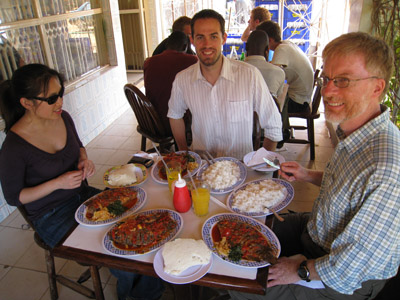
We took a break for lunch. That big blob of white stuff on the plate in front is ugali, which is made of flour and water and has the consistency of playdough. You eat it with your hands - first you take a little ball of it and squish it with your fingers until it becomes malleable, and then you use it to scoop up other food. We ate it with tilapia from the nearby Lake Victoria. Definitely my most adventurous meal so far.
Next we rode to Kisumu, where Obama has his African roots.
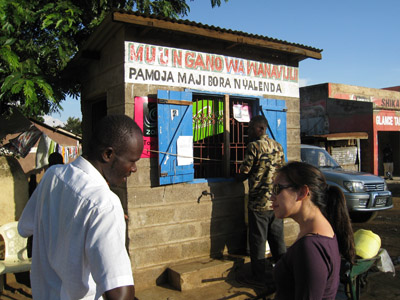
This is an urban water kiosk we visited. This kiosk charges 3 Kenyan shillings (about 4 cents) for 20 litres of unchlorinated water, or 4 Kenyan shillings for 20 litres of chlorinated water. The kiosk also sells drinkable water to bodaboda drivers at one shilling a cup - a shrewd business move. Despite the huge markup, it's worth it to a thirsty bicyclist; we saw a bunch of bodabodas hanging out here in front of the kiosk.
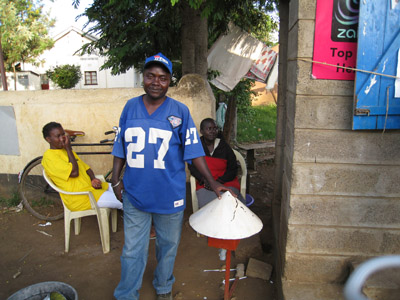
Here's the owner of the kiosk standing proudly next to his chlorine dispenser.
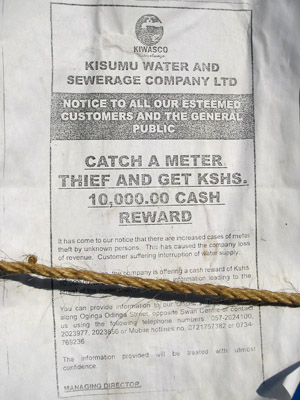
This sign was posted on the water kiosk by the water company.
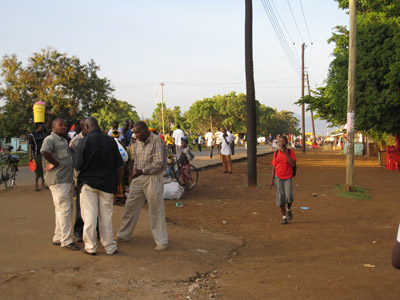
This was the street by the water kiosk (click for more detail).
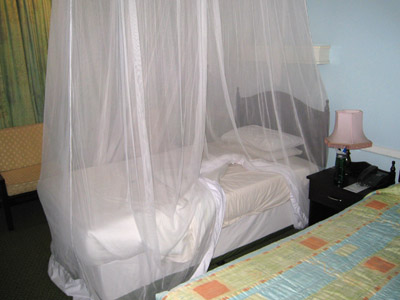
We stayed at the Imperial Hotel in Kisumu. All the hotels in western Kenya provided mosquito nets over the beds - even the Blue York. At the Imperial Hotel they even prepare the mosquito net for you.

This was the switch outside the bathroom for the water heater.

This was the shower, with a built-in instant water heater.
I switched on the water heater before attempting to shower, optimistically assuming this would cause the hot and cold water taps to work like they would in a regular shower. But no. The hot water tap controlled nothing; only the cold water tap would cause water to come out. The water started off frigid; then the heater gradually warmed it until it was scalding. Since there was no in-between setting, taking a shower consisted of standing under the water until it was burning hot, then running out (naked and dripping) to turn off the heater, returning to continue washing until the water was cold, running out to turn on the heater, washing until the water was scalding, running out, etc.
Of course, I know I should be thankful that there was any hot water at all.
We headed back to the IPA office for more tours of water sources and chlorine dispensers.

They had this amusing Obama calendar on the wall (click for a bigger view). Jeff later explained to us that the entire country just went nuts when Obama was elected - and not just Kenya but other African countries as well. Uganda had a two-day national holiday.

This was a well we visited in a peri-urban setting.

And this was the dispenser next to it. We had a long conversation with the woman who was in charge of refilling the dispenser, with Bukeke helpfully translating our questions into Swahili. She told us that the dispenser was like a blessing to her family. Before they had the dispenser, nearly every week, someone in her family would be sick and would have to go to the hospital; now, that hardly ever happens.

This was a family compound we visited in a rural area near Busia. Jeff explained that this was a pretty well-to-do family, comparatively speaking - in addition to the mud huts, they had one building with a corrugated metal roof (which you can just see behind the hut on the left), and a metal roof was a sign of wealth.

To get to the water source, we took a five-minute walk through some fields of cassava.

The water source was a protected spring, built by a previous IPA project.

This was the chlorine dispenser next to the spring.

We took a break for lunch. That big blob of white stuff on the plate in front is ugali, which is made of flour and water and has the consistency of playdough. You eat it with your hands - first you take a little ball of it and squish it with your fingers until it becomes malleable, and then you use it to scoop up other food. We ate it with tilapia from the nearby Lake Victoria. Definitely my most adventurous meal so far.
Next we rode to Kisumu, where Obama has his African roots.

This is an urban water kiosk we visited. This kiosk charges 3 Kenyan shillings (about 4 cents) for 20 litres of unchlorinated water, or 4 Kenyan shillings for 20 litres of chlorinated water. The kiosk also sells drinkable water to bodaboda drivers at one shilling a cup - a shrewd business move. Despite the huge markup, it's worth it to a thirsty bicyclist; we saw a bunch of bodabodas hanging out here in front of the kiosk.

Here's the owner of the kiosk standing proudly next to his chlorine dispenser.

This sign was posted on the water kiosk by the water company.

This was the street by the water kiosk (click for more detail).

We stayed at the Imperial Hotel in Kisumu. All the hotels in western Kenya provided mosquito nets over the beds - even the Blue York. At the Imperial Hotel they even prepare the mosquito net for you.